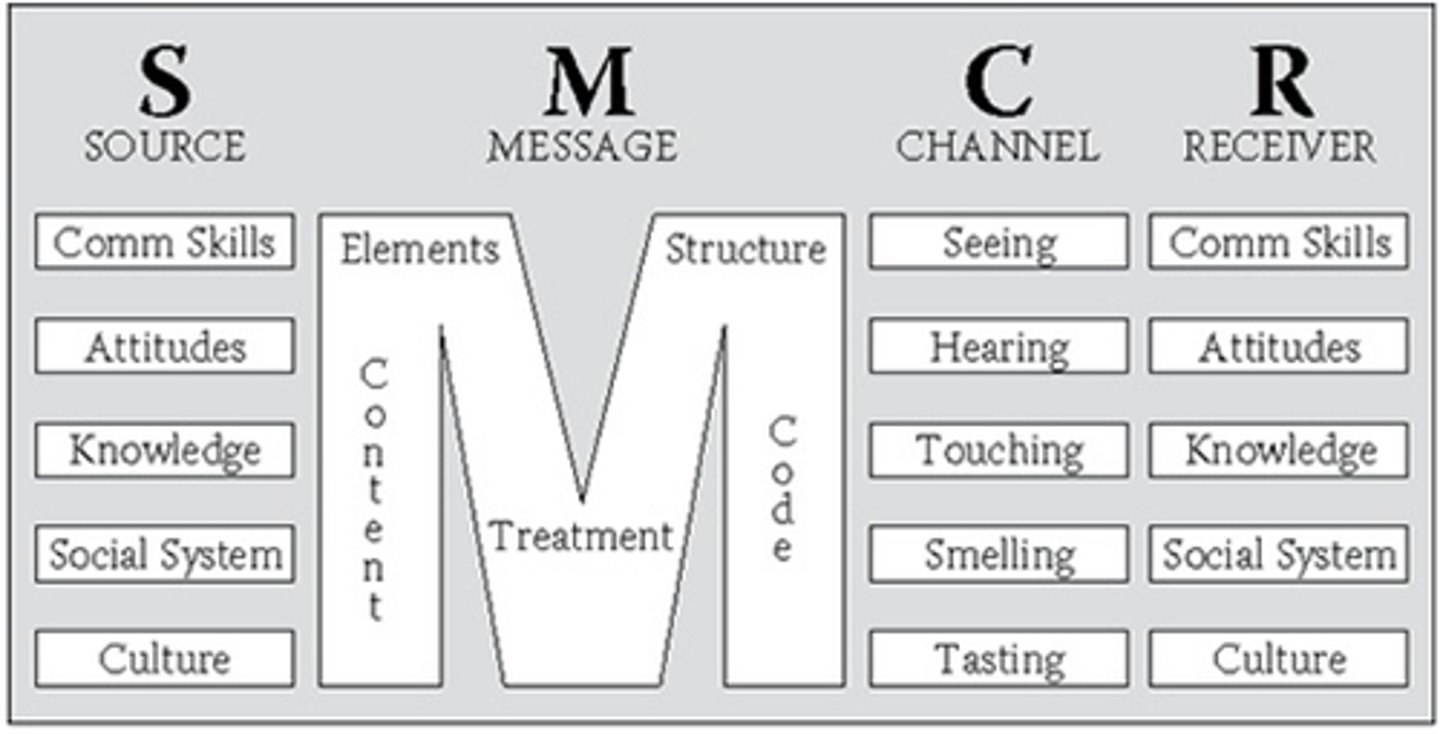Purposive communication
1/59
There's no tags or description
Looks like no tags are added yet.
Name | Mastery | Learn | Test | Matching | Spaced |
|---|
No study sessions yet.
60 Terms
Communication
exchange of thoughts, ideas, concepts and views between people
context
is the circumstance or environment in which communication takes place. Such circumstance may include the physical or actual setting, the value positions of a speaker/listener, and the relevance or appropriateness of a message conveyed.
communication mode, context, purpose and style
3 kinds of communication
verbal-non verbal communication
Effective communication calls for the blending of these two types. One cannot be separated from the other.
visual communication
The type of communication that uses visuals to convey information and/or messages.
intrapersonal communication
Self or inner talk, inner monologue, or inner dialogue.
interpersonal communication
-Interactive exchange
-Can also occur in small groups aka group communication.
extended communication
-Involves the use of electronic media.
-Unlike before when it only called for the use of television and radio, nowadays, the description of it may be expanded to include tele, phone conferencing, video-confering, Skype calls, and other technological means.
organizational communication
-Role of organization communication plays in organizational contexts; comprises individuals who work for a company.
-For an organization to be successful, a system of communication should be established; set of rules and standards for communication protocol.
formal structure, informal structure
2 types of organizational structure
formal structure
Allows communication to take place via designated channels or messages flow between positions in the organization.
downward communication, upward communication, horizontal communication, crosswise communication
four approach of formal structure
informal structure
-Comes from unofficial channels of message flow.
-Also known as 'grapevine'
-Occurs due to dissatisfaction of some employees accompanied by uncertainty
-Gossips, rumors, favoritism
intercultural communication
-Communication between or among people who have different linguistic, religious, ethnic, social and professional backgrounds. Even gender difference affects communication.
-Individuals having different orientations communicate and interpret messages differently; verbal and non-verbal.
formal communication
-Employs formal language delivered orally or in written form.
-Lectures, public talks, speeches, research and project proposals, reports, laws and business letters are considered formal situations and writings.
informal communication
Involves personal and ordinary conversations with friends, family members and acquaintances.
Be clear with your purpose
Be complete with the message you deliver
Be concise
Be natural with your delivery
Be specific and timely with your feedback
principles of effective oral communication
Clarity
Conciseness
Concreteness
Correctness
Cohesion
Completeness
Courtesy
principles of effective written communication
communication mode
-Refers to the channel through which one expresses his/her communicative intent.
-It is the medium through which one conveys his/her thoughts.
-Views or feelings can be communicated through face-to-face interaction, video or audio.
Face-to-Face
Video
Audio
Text-based Communication
modes of communication
face-to-face communication
-It is an informal or casual conversation between two or more people.
-People engage in social conversations to establish relationships or maintain them. It is one way of gaining new acquaintances or friends.
how to speak
what to speak
when to speak
to whom you are speaking
face-to-face speak list
video communication
-Web cameras are used so that two or more people who cannot interact face-to-face can communicate.
-If there are no technical glitches encountered, this could be a very effective mode of communication especially for people separated by distance.
audio communication
-In this mode of communication, only the voice of the speaker is heard. Ordinarily through telephone or answering machine.
-An obvious downside is not being able to see the body language or cues of the person you are talking to.
-Especially difficult when listening to people with different accents.
text-based communication
-Email, text messaging, instant messaging and social media networking sites offer text-based interaction.
-Has a wider reach than video and audio and can disseminate information to a bigger audience quickly.
Lasswell

David Berlo

Shannon and Weaver

code
is a system of rules to convert info
tone, pronunciation, diction, accent, speed
verbal cue's
high context culture
-leaves the message unspecified
-understood through non-verbal cues and between the line interpretation
arabs, central european, latin americans, asian
countries under high context culture
inner circle, outer circle, expanding circle
3 concentric countries
low context culture
-straight to the point
-expect message to be explicit & specific
germanic and english speaking countries
countries under low context culture
sequential culture, synchronic culture
2 types of time culture
sequential culture
business people give full ambition to one agenda item after another
synchronic culture
long-term planning time is viewed as a sort of circle (past, present, future)
north america, english, swedish, dutch
countries under sequential culture
south america, asia, southern europe
countries under synchronic culture
relational culture
affective and neutral
affective culture
-emotions are explicitly stated and shown
-people freely express what they feel readily showing emotions
philippines, france, italy, australia
countries under affective culture
neutral culture
-does not really show emotion
-conservative
-monitor the amount of emotions they display
japan, korea, china
countries under neutral culture
inner circle
countries that view English as their native language (ENL)
americans, europeans, australians, new zealand
countries under inner circle
outer circle
English as a second language (ESL)
philippines, bangladesh, kenya, india, malaysia
countries under outer circle
expanding circle
English as a Foreign Language
china, japan, korea, indonesia, taiwan
countries under expanding circle
lexicon
varieties of english
language register
formality of a language
formal register
employs formal language
informal register
employs informal language
job interview, proposals, organizational journal, professional objective, objective partial
formal register example
jargons, casual, textese, colloquial words
informal register example
language style
-degree of formality of the language
-context or the social situation
academic, textese, legalese, professional
examples of language style
language genre
-associated with the organization of culture
-is a set of language system